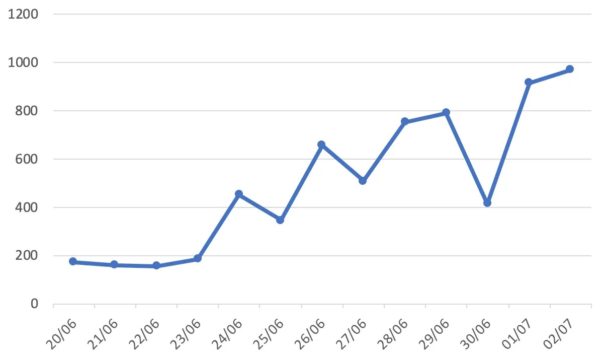In late June, the Matanzas province saw a sharp increase in COVID-19 cases, with an infection rate which went up from 438 cases per 100,000 inhabitants on June 28th, to over 800 cases per day per 100,000 inhabitants, on July 2nd, according to Giron newspaper. This has turned the epidemiological situation in this province the most difficult in Cuba.
[Editor’s Note: On Tuesday July 7th the number of positive cases in Matanzas was 1,327 of the record total of 3,819 in all of Cuba. Havana was in second place with 645 positives.]
According to Mario Sabines Lorenzo, the province’s governor, there was a new outbreak of the disease that began in the Los Arabos, Cardenas and Matanzas municipalities, that then extended to Colon, Jaguey and other areas.
On June 28th, the Cuban minister of Public Health, Jose Angel Portal Miranda, explained that high transmission rates are connected to the circulation of highly contagious strains of the virus, such as the Delta variant, which cuts the time between showing the first symptoms and the development of the disease. It causes severe damage to cells in a very short period of time, with episodes of diarrhea and fever, as a precursor of respiratory problems.
This strain was detected in India initially, back in October 2020, and it is now present in 98 countries. “Its higher transmission rate, with an infection rate that is approximately 60% higher than the original virus, plus its ability to mutate, makes it a very dangerous variant,” the United Nations (UN) has pointed out.
On July 1st, Giron newspaper reported 5,067 native cases diagnosed in the Matanzas province, over the past 15 days, with an infection rate of 703.9 per 100,000 inhabitants. Meanwhile, only 5 of the 971 cases confirmed on July 2nd were imported, according to statistics from the Ministry of Public Health (MINSAP).

Matanzas currently has 105 isolation centers and capacity for almost 6000 people; but Sabines Lorenzo specifies that they need 3000 more beds to cover the province’s needs in the face of a surge in cases. The governor also pointed out that there are shortcomings in epidemiological care, in the implementation of biosafety measures in isolation centers and hospital facilities, and the proper functioning of border control points between provinces and municipalities.
It is estimated that 90% of the population in the Matanzas, Colon and Cardenas municipalities receive the third dose of the potential Abdala vaccine, by the first weekend in July. In the meantime, 50% of residents in Limonar and 63% of residents in Cienaga de Zapata had received the first dose, on July 1st.
Nevertheless, the presence of new cases in the province among people who have already received all three doses of the vaccine, proves that people need to continue to respect physical distancing and hygiene measures, because of the time it takes to gain immunity after having the vaccine.
According to the World Health Organization (WHO), the level of protection people have during the first fortnight after having the vaccine is not significant, but then gradually increases. The WHO has also explained that while vaccines protect people against more severe forms of the disease, it remains unknown to what extent vaccinated people can become infected or transmit the virus to others.
The municipalities with the highest infection rates in the province are Matanzas, Cardenas, Limonar and Los Arabos. Infection Rate (per 100,000 inhabitants) of autochthonous cases by municipality in the past 15 days (until July 1st). Source: Giron Newspaper.
As a result, Sabines Lorenzo is urging people to stay in strict quarantine, for at least 20 days after the third dose of the potential vaccine. The governor also pointed out that, in spite of high infection rates in the province, there is still excessive movement of people on streets, some of whom aren’t wearing a mask properly, and are even holding parties at private residences.
So, a series of measures and restrictions have been adopted, with the purpose of containing the new outbreak. According to Sabines Lorenzo, only the key staples of the economy, including food production, distribution and sales to the population, are still operating; and interprovincial and intermunicipal transport has been suspended.
Furthermore, Giron Newspaper explained that the decision has been made to keep blocks with five confirmed cases in lockdown with restrictions on movement, without exceptions, for 10 days.
It was also decided that lab research would be stepped up in order to seek out asymptomatic cases; restricting movements of people and vehicles from 8 PM until 5 AM; limiting the number of standing passengers in buses to 15; as well as no longer allowing people to leave the province for professional reasons to every state body and institution.
Remote working in jobs and positions that allow for this mode of work has also been encouraged; and there are more home consultations from the Family Healthcare System, at no cost to the patient. Some basic products are only being sold to residents in the store’s municipality; and they have reinforced Decree Law 31/2021, which is to do with wearing a mask incorrectly, people hanging out in parks, parties being held and other health regulations.
This article was translated into English from the original in Spanish.











Comments
We moderate comments on this site. If you want to know more details, read our Privacy Policy
Your email address will not be published. Mandatory fields are marked with *